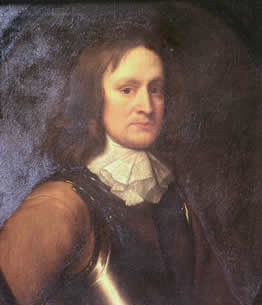John Hampden

John Hampden
Hampden came from an ancient Buckinghamshire family with a long history of service to the crown. His mother, Elizabeth, was the daughter of Sir Henry Cromwell and was Oliver Cromwell's aunt. During the years leading up to the Civil War he emerged as one of the leading architects of the resistance to Charles I’s arbitrary rule. He was imprisoned with others in 1626 for refusing to pay a so-called forced loan to the king. It was, however, as a result of his stand against the imposition of the illegal Ship Money tax that he came to national prominence.
Hampden was probably educated at Thame Grammar School. He entered Magdalen College Oxford in 1609 and was admitted as a barrister of the Inner Temple in 1613. In 1619 he married Elizabeth Symeon, daughter of Edward Symeon of Pyrton. They had nine children, including three sons. Elizabeth died in childbirth in 1634. He married Lady Letitia Vachell, a widow and daughter of Sir Francis Knollys, in 1641.
Hampden was first elected to Parliament in 1621 as Member for Grampound in Cornwall. He was re-elected for Grampound in 1624, but in 1625, 1626 and 1628 was returned for the newly re-enfranchised borough of Wendover. He was returned, with his friend Arthur Goodwin, for Buckinghamshire in both the Short and the Long Parliaments of 1640.
Hampden was a tireless worker in Parliament and sat on numerous committees in the Short and Long Parliaments. He played an important part in both the negotiations with the invading Scots and the impeachment of the King’s chief minister, the Earl of Strafford. It was, therefore, not surprising that he was one of the five MPs that the king accused of treason and tried to arrest in January 1642.
When civil war seemed inevitable Hampden raised his own infantry regiment, the Buckinghamshire Greencoats, and rallied support for Parliament. At the battle of Edgehill in October 1642 he and his regiment defended Parliament’s artillery train from attack by Prince Rupert's cavalry. On the 12 November he and his troops were probably at Acton when they heard of the royalists' surprise attack on Brentford. They arrived at Chiswick in time to cover the retreat of the parliamentarian soldiers, charging the royalists five times and so halting their advance on London.
The following day, at the battle of Turnham Green, Hampden and his men were involved in the only offensive action initiated by the Earl of Essex, commander of the parliamentary army. However, no sooner had Hampden reported that his men were in position to attack the royalists than Essex countermanded his original orders.
In April 1643 Hampden and his regiment were part of the army that successfully besieged Reading. He was wounded a few weeks later, on 18 June, at the battle of Chalgrove. He died six days later in Thame.
After his death his integrity and bravery were long remembered. In the eighteenth century his stand against taxation without representation was admired by the American colonists. Hampden Clubs were formed during the early nineteenth century in several British cities to discuss and promote constitutional reform. Much of what he had fought for was later enshrined in the 1689 Bill of Rights. His political legacy can therefore be found in the constitutions of many of the world’s leading democracies.

